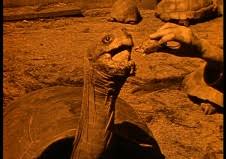“From the Belly of the Earth” AKA “Uit den schoot der aarde” was released in 1919. The director is unknown. It is a Dutch educational silent short and is about ten minutes long.
The film provides information on the evolution of life on Earth from reptiles to apes. The film tries to provide information based in the current science of the day. Some of the information has since been proven to be incorrect. There really isn’t much to the film, nor is it all that informative, but it does have some nice photographs of dinosaurs.
The dinosaurs in the film are pictures of statues on display at Carl Hagenbeck’s Tierpark in Hamburg, Germany. The Hagenbeck Tierpark or Zoo was founded by Carl Hagenbeck Jr. in 1907. The zoo’s main feature is that it was the first to use cageless enclosures for its animals. Instead, they used moats, natural rock formations as well as artificial landscape designs to give the animals a more comfortable and real-life experience. The zoo itself has a long and somewhat sordid past, not for its treatment of animals but for its human exhibits.
I don’t have captioning for the intertitles of the film, but I do have a transcript of them.
- From the womb of the Earth
- Great plumes of smoke spread about the perimeter and herald an approaching volcanic eruption.
- Thick clouds of smoke obscure the environment.
- In the crater it boils and fizzes as in a witch’s cauldron.
- When the lava has cooled, strange plants develop on the lava-like bottom.
- From imprints left in the lava, it is possible to determine which animals lived on the volcano during different periods of rest.
- Many peculiar forms are still found.
- The Diplodocus must have lived here three million years ago. The length of this monster was more than 30 meters.
- Don’t you believe that? Well, the discovered skeleton provides the irrefutable proof.
- The large turtles, which are still found today, remind us of the life of their predecessors of much larger dimensions.
- A million years ago there also lived a strange mammal, the saber-tooth tiger.
- The found skeleton proves that the animal existed.
- The strange animal, the hydrx, has been known for many centuries.
- The skull of the hydrx.
- The animal belongs to the hippopotamus family.
- Over the centuries, the lineage of apes also developed. The gorilla is one of the oldest species.
- A young chimpanzee.
- The actions of these animals show intelligence and deliberation.
- The gibbon.
- In the wild, the orangutan is one of the most intelligent species.
- It is sometimes claimed that these animals even possess a sense of art.
- A beautiful collection…
- …Of prehistoric animals
- We'll spare you the names of all these lovely creatures. Suffice it to say, that they all end in “aurus”.


